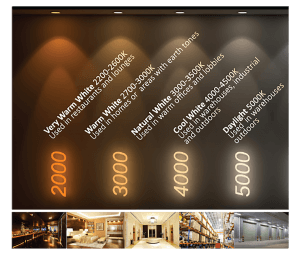LED Brightness Control for Commercial Properties
By Leah • Mar 04, 2019
There are various reasons why you will need to control the brightness of your LED bulbs. This is the same for residential as well as commercial and industrial properties, even if the considerations are on different scales. Here we share these reasons as well as tell you why LED is the ideal type of lighting system for brightness control.
What Type of Light Does LED Provide?
As with any developing technology, LED lighting has at one point had certain limitations. Part of the problem was its inability to provide 'white' light. This is light which is most useful in commercial properties for a variety of reasons.
The main reason is that bright white light has an effect on the body, making it feel more energized. Workers are less tired, more engaged and better able to see their work. This reduces tiredness and accidents, while concurrently increasing productivity. The light temperature is measured in Kelvin units and bright white light has a range of light between 3500K and 4100K.
Previously, the closest to white LED lighting was able to provide was blue-white light (4600K and above). This type of light contributes to eye strain and can even lead to visions loss with overexposure. However, just like UV light from the sun, it is also an important part of earth's ecosystem. The problem with LED was the inability to create the right light at the right time.
However, it was discovered that phosphor could be used as a filter for blue light LED to create the bright white light needed for productive workspaces. This opened up a new era of lighting as the benefits of LED in terms of energy efficiency and cost effectiveness finally met with the right kind of light quality.

Why LED is the Best for Brightness Control
The combination of production costs going down and government subsidies for companies to use LED has meant this technology has never been more accessible. But it wouldn't be used if it wasn't effective. Fortunately, light quality is not only better, but it is more manageable.
For high intensity discharge bulbs such as metal halide or high pressure sodium lamps, the light is omnidirectional. You can use reflectors to send some of that light back, but it is still inefficient. With LEDs you can direct the light to where you need it and only where you need it.
HIDs also need time to warm up, LEDs do not. Neither do they suffer from the lumen depreciation of metal halides and similar bulbs.
This combined ability to create ideal light, angle it in the right space and reach optimal brightness instantaneously means that it is the ultimate in terms of control. You can use brightness control units to change the brightness at any point, dimming the lights to a fraction of a percent of the output (even if there would be little need to go this low).
You can manually control the brightness or even use light sensors to monitor the ambient light levels and change it accordingly. If you need to do different things in different commercial spaces, you can pre-program brightness and color settings to be changed to your lighting templates instantly. Motion sensors also allow you to turn the light to full brightness when needed and turn off when not in use. This saves more money and reduces energy consumption even further.
